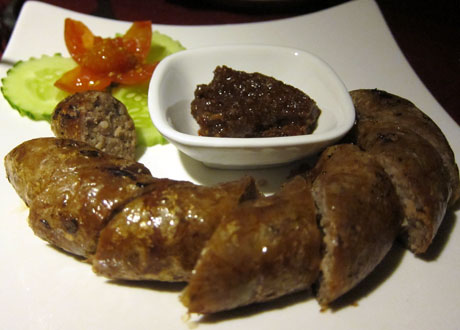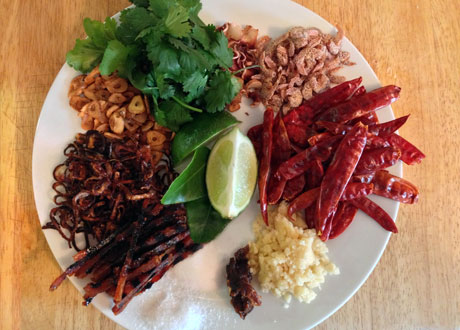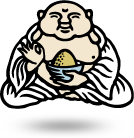Jaew Bong: Magical Laos Chilli Paste
Posted by Mark Busse on Sunday, May 12th, 2013Tags for this Article: dipping sauce, jaew, jeow, Laos, Luang Prabang, mark busse, recipe

Jaew Bong served with buffalo sausage in Luang Prabang, Laos.
As with most nights during our month in Southeast Asia, the air was hot and muggy the evening we arrived in the village of Luang Prabang, Laos. The air was thick with the sounds of crickets, frogs, and other unseen creatures that called the jungles along the Mekong River home. We were hungry and ventured out into the inky dark to to explore, crossing the Nam Kahn River using a rickety bambo bridge (which apparently needs to be rebuilt after each rainy season) and walked along the quaint row of French colonial style buildings and restaurants along Kingkitsarath Road.

Andrea crossing the bamboo bridge over the Nam Kahn River.
Having put our names on the list at Tamarind Restaurant (where days later we would take cooking classes), we settled in across the street for a snack and cold beverage and to listen to the river peacefully burbling nearby. It was one of the magical moments in our trip where we were truly in that moment, suddenly keenly aware of the place around us and how intensely different it was, not only from home obviously, but from any of the other Asian cities we’d visited previously. We were in the heart of Luang Prabang, the former capital and royal seat of government for the Kingdom of Laos, former French colony, and UNESCO World Heritage Site.
Although a privilege to visit this amazing place (we’d definitely go back and recommend you go soon), this story is not really about Luang Prabang—it’s about their magical chilli paste called Jaew Bong.

My hand-written instructions in Laos for Jaew Bong.
The first time I tried Jaew Bong, it was served with a grilled local sausage made from water buffalo. The meat itself was tasty enough, although a little bland and dry, but when dipped into the Jaew—POW!—the flavour explosion was intense and unforgettable. I was so impressed by this spicy, salty, sweet, and umami-packed paste I asked the waitress to write down a note I could bring to the market to secure some later.
Sometimes spelled Jeow or Jaeo, with versions also found in nearby Thailand and Cambodia, Jaew is a dipping sauce to add flavour to sticky rice or other bland foods commonly the only thing people in the northeastern region of SE Asia could historically afford to eat. A chicken or pig is a treat, and slaughtering an animal like a buffalo is reserved for special occasion like a wedding or religious ceremony, so they create flavourful dipping sauces that can be used to make a boring meal of sticky rice or green algae (called Kaipen) tasty.
I was completely hooked the first time I tasted Jaew Bong and knew I had to figure out how to make it at home. Although there are myriad variety of Jaew, “Jaew Bong” is a pickled version made with dried water buffalo skin (by the way, if anyone knows where to get some dried buffalo skin, please let me know), and with a little guidance from Google, I experimented with a couple recipes and ratios until I got a close approximation and have shared my recipe below.
Jaew Bong Chilli Paste
- a handful of whole red chillies (the little hot bastards) roasted until brittle (I then soaked them in rice wine and warm water so they’ve turn to paste easier)
- a pile of deep fried sliced garlic
- a bunch of sliced and deep fried red shallots
- a little deep fried galangal
- a little palm sugar
- a little salt
- a little MSG (found in everything in the region)
- a glug fish sauce
- some lime juice
- a little of the oil used to fry the garlic, galangal, and shallots
- some sawtooth coriander leaves
- a couple kaffir lime leaves
- a little tamarind paste
- some dried shrimp
- some dried buffalo meat (I used jerky as a substitute)
- in Thailand they add toasted rice powder, which I couldn’t find locally

Ingredients for Jaew Bong chilli paste.
You’ll notice how loosey-goosey I’ve been with my measurements. This is intentional as no self-respecting Laos cook would use measurements to make something like Jaew, but rather use instinct and taste to guide the process. The ingredients in the photo above, combined with some fish sauce, tamarind paste, and oil are what I started with and then adjusted at the finish.
The preparation method is quite simple. Start by roasting the ingredients (they do this over charcoal in Laos), then pulverize everything in a mortar & pestle, followed by additional roasting in a little of the oil left from frying the garlic, galangal, and shallots. I added a little hot water and some of the left over garlic/shallot vegetable oil from deep frying to give it more of a paste texture.
We’ve tried Jaew Bong with sticky rice, toast, eggs, and various kinds of grilled meat. It literally goes with anything that you might add hot sauce or ketchup to—only it’s WAY better. Because of the presence of chilli, oil, citrus acid, and salt, Jaew bong is essentially pickled and keeps for weeks.
Note: If you are lucky enough to live in the very Asian food friendly city of Vancouver, there is a store called Asia Market on Hastings (between Main & Gore) that specializes in Thai ingredients that sells almost all the ingredients as well as a similar Thai chill paste in a jar (although not the same as fresh).
Enjoy!


Posted on May 23rd, 2013
Pailin Chongchitnant says:
Mark, toasted rice powder is something one usually makes not buy. You can buy it (at Asia Market), but the fragrance is very fleeting once you open the package, so it’s best to make it fresh each time you need it. It is sooooo easy, I always make it only when I need to use it, and I don’t even bother to keep any extra because it won’t be as good the next time I need it. Here goes: Take raw sticky rice, or even jasmine rice, toast it in a dry sauté pan until deep brown colour (move it constantly). Then grind it with a mortar & pestle or in a coffee grinder. DONE! It adds such a beautiful aroma to everything.
Posted on April 15th, 2017
margo says:
I reckon pork skin would be a good substitute for buffalo skin – both very chewy. If you make bacon or pancetta, I’d say this would be an excellent substitute if you peel it after curing (easier anyway).